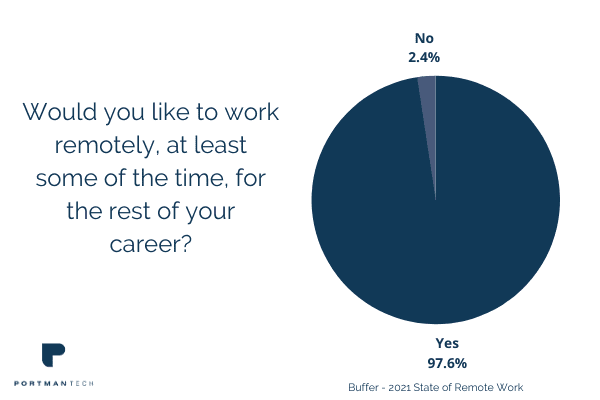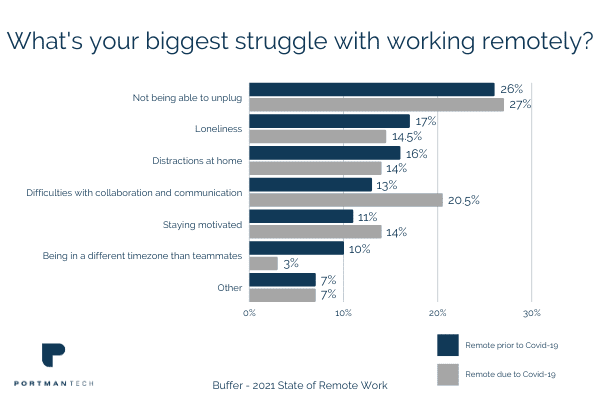
Microsoft Copilot: IT Managed Services & AI Integration for Businesses
Revolutionize your service desk! Microsoft Copilot offers IT managed services & AI integration. Enhance your business with AI-powered service & expert IT management.
Your London Telecoms and IT partner

The global coronavirus pandemic presented many new challenges for businesses, forcing them to work in ways that were either previously unheard of, or were extremely rare.
For many businesses remote working has proved successful, many companies are looking to continue a hybrid working lifestyle post-pandemic, with employees maintaining a combination of being in the office and working remotely.
However as businesses decide to move forward, there is still the overwhelming need for offices to make infrastructure changes to both the physical office space as well as technology changes in order to adhere to this new way of working.

With 97% of respondents to Buffer’s State of Remote Work answering that they’d like to work remotely at least some of the time, it’s vital that businesses are able to support this successfully.
“Social distancing”, a word that made its debut in the dictionary just some 12 months ago, has come to be a term used in everyday life, and will continue to be as workers slowly make their return to the office.
One of the most common changes businesses will make to their physical office structure will be reducing staff levels onsite in order to reduce the risk of transmission.
This will likely go hand in hand with practical arrangements such as placing desks further apart and installing perspex screens to make the space covid-safe.
Meetings may need to take place in larger meeting rooms, allowing for employees to be further spaced out within the meeting rooms. Hybrid working or in-office rotas will require some meeting attendees to dial in remotely.
Ultimately, meeting rooms will need to be adapted prior to employees returning to the office, ensuring that productivity levels are maintained without disruption.
Updating audio-visual (AV) equipment such as video conferencing tools and including microphones will be vital in ensuring that hybrid-working is successful, allowing employees to collaborate seamlessly.
If team members are spaced out within the meeting room, it’s important that each employee can still be seen on the video call
Equally, microphones will need to be able to pick up everyone in the room, to ensure everyone can be heard
IoT (Internet of Things) room sensors can monitor whether meeting rooms are occupied and can even release booked meeting rooms when occupants haven’t turned up to a scheduled meeting. This provides a flexible solution for employees whose plans will inevitably change frequently.
16% of employees find difficulties with collaboration and communication to be their biggest struggle with remote working
Buffer State of Remote Work, 2021
While remote working was not a new concept and businesses have adapted well over the past year, it is alarming that a number of employees find communication and collaboration their largest struggle whilst working remotely.

What’s more interesting is the increase in new remote workers who find communication and collaboration their biggest struggle in comparison to those who were already working remotely prior to the pandemic.
This can be explained by the fact that pre-pandemic, employers offering remote work had flexible infrastructures already in place, and equally did not have to accommodate for such a high volume of remote workers.
In comparison, businesses that did not offer such flexibility had to adapt swiftly, ultimately cutting corners. For many SMEs, the adoption of remote working was an unexpected change, meaning that infrastructures were put in place as temporary, quick fix solutions.
Businesses have more than likely already made adjustments to their unified communications solutions, but there is clearly still a way to go to enhance collaboration among employees who will be working from home long term.
One of the most effective ways to improve collaboration and productivity is to migrate your services to the cloud. Using the cloud means that employees can access their data from anywhere, whether they’re in the office or remote working. Having accessible data anywhere is just one benefit of using the cloud.
Flexibility is a core component that needs to be considered as businesses plan for the return to the office.
Whether moving offices due to requiring less physical space and downsizing, or shifting to a flexible working model, it’s important that your IT solution meets the needs of not just your employees, but the business as a whole too.
If you need advice or assistance on how to ensure your return to the office is smooth sailing, feel free to contact our team of IT experts.
ABOUT THE AUTHOR

Vikas Shah joined Portman Tech as Chief Technology Officer in 2018. IT has always been his passion and he has built his career around technology. Vikas closely follows developments in technology, providing clients with solutions that fit their requirements.

Revolutionize your service desk! Microsoft Copilot offers IT managed services & AI integration. Enhance your business with AI-powered service & expert IT management.

Discover what VoIP is, how it works, and the best service provider for small to medium businesses. Explore the difference between landlines and VoIP, and the appealing features and tools available.

VPNs for Business: – In today’s business world, it’s essential to protect your company’s data and your employees’ privacy. A VPN can be a valuable tool for achieving this goal.

0800 862 0120
hello@portmantech.com
123 Aldersgate Street, London EC1A 4JQ